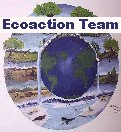Announcements and News:
Site Navigation:






Page address:
File created:
Sep 5, 1998
Last modified:
Apr 1, 2002
Definitions:
Double-click on any word
Announcements and News: |
|
As a magma plume rises and cools, crust material melts into it, and dense, high melting point minerals begin to crystallize on the bottom. |
|
Hotter areas of the mantle cause rock in the asthenosphere to rise. |
|
As dense, high melting point minerals crytallize, chromium, iron, and oxygen combine to form the mineral chromite. |
|
As that area of the continent becomes lighter due to erosion, the continent rises, bringing the chromite closer to the surface. |
|
Two tectonic plates push together at a converging boundary. |
|
Melted rock in a subduction zone begins to rise and to cool. |
|
The magma that did not solidify at the base of the magma chamber cools slowly to solid rock such as granite. |
|
Radioactive decay of elements in Earth's core and mantle cause extreme heat. |
|
Erosion removes miles of rock from above the chromite. |
|
A convection current of slow moving rock in the asthenosphere moves the more rigid rock of the lithosphere horizontally. |
|
Thin, basaltic crust is pushed under another plate, and melts in a subduction zone. |
|
After many years the kitchen sink is replaced, and gets melted down to make something new. |
|
The ore is heated to melt the chromium away from the iron, and a chemical reaction removes the oxygen. |
|
A shaft is blasted through overlying rock to the chromite deposit, and the overburden is piled nearby. |
|
The ore is crushed, and chromium rich rock is separated from rock with less chromium. |
|
Geologic studies and drilling into the crust indicate a rich chromite deposit.
|
|
The chromite and other rock is dug out and transported to the surface.
|
|
The gangue is piled and covered with plastic.
|
|
The purified chromium is combined with iron and other metals to make stainless steel. |
|
The stainless steel is manufactured into a kitchen sink.
|




Page address: